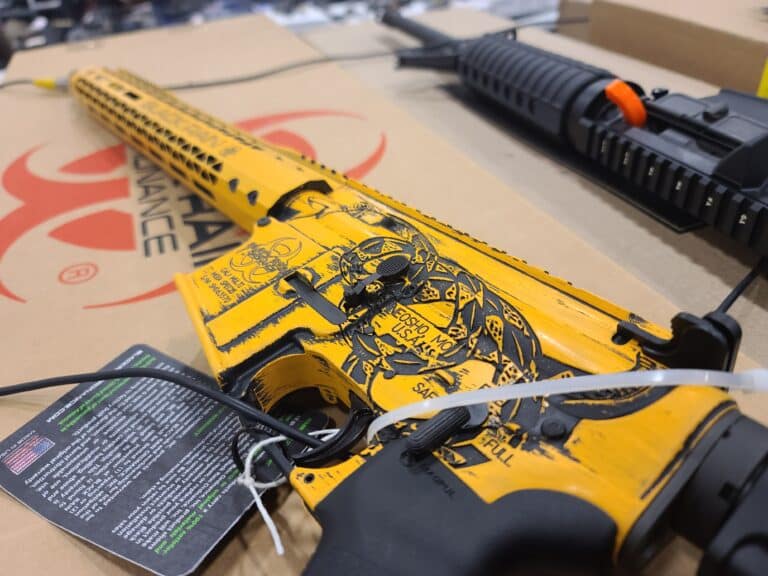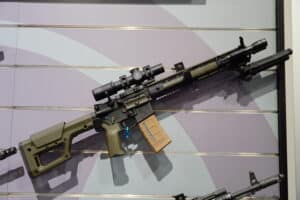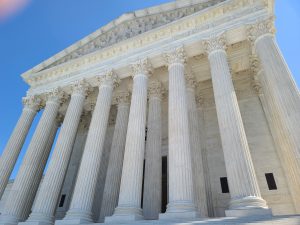The Fourth Circuit Court of Appeals has once again found Maryland’s so-called assault weapons ban is constitutional.
In a ten-to-five ruling on Tuesday, a full panel of the appeals court determined the Old Line state’s ban on AR-15s and similar firearms does not violate the Second Amendment. It found the banned guns fall outside the protections guaranteed by the Constitution. Using similar reasoning to the last time the panel ruled on the same law in 2021, the majority decided semi-automatic assault weapons are too similar to military weapons to fall under the Second Amendment.
“The assault weapons at issue fall outside the ambit of protection offered by the Second Amendment because, in essence, they are military-style weapons designed for sustained combat operations that are ill-suited and disproportionate to the need for self-defense,” Judge Harvie Wilkinson wrote for the majority in Bianchi v. Brown. “Moreover, the Maryland law fits comfortably within our nation’s tradition of firearms regulation.”
A lot has changed in Second Amendment jurisprudence since the appeals court ruled on the ban in 2021. The most significant was the Supreme Court’s 2022 decision in New York State Rifle and Pistol Association v. Bruen, which established a new test for Second Amendment cases. The Court then vacated the Fourth Circuit’s ruling in Bianchi and sent it back down for reconsideration in light of the new test. The Fourth Circuit delivering the same result once again could provide reason for The Court to take up the case, especially since it has now reached a final conclusion on the merits.
The Supreme Court has been reluctant to take up Second Amendment cases in recent months and declined to grant certiorari in all of its pending gun cases last month. That included denying a request to take up a collection of cases challenging the Illinois assault weapons ban. However, Justice Clarence Thomas suggested that reluctance was based on the fact those cases were at the preliminary injunction stage rather than final judgment.
“This Court is rightly wary of taking cases in an interlocutory posture,” Justice Thomas wrote. “But, I hope we will consider the important issues presented by these petitions after the cases reach final judgment. We have never squarely addressed what types of weapons are ‘Arms’ protected by the Second Amendment.”
The Fourth Circuit did address what types of arms are protected or, at least, which ones aren’t. The majority looked primarily at the Supreme Court’s holding in 2008’s DC v. Heller decision, which recognized an individual right to keep and bear arms while striking down the city’s handgun ban, as well as dicta in the case.
“As recognized in Heller, ‘the Second Amendment right … extends only to certain types of weapons’; it is ‘not a right to keep and carry any weapon whatsoever in any manner whatsoever and for whatever purpose,'” Judge Wilkinson, a Ronald Reagan appointee, wrote for the majority. “Arms typically used by average citizens for self-defense are generally within the ambit of the Second Amendment, presumably because these arms had proven over time to effectively amplify an individual’s power to protect himself without empowering him to singlehandedly reign terror upon a community.”
Judge Wilkinson pointed to Heller‘s description of short-barrel shotguns and “M-16 rifles and the like” as weapons the government can ban. He said there was a common thread that connected those firearms, which also extends to semi-automatic AR-15s and the other guns Maryland bans.
“What brings all the weapons beyond the scope of the Second Amendment together, and what separates them from the handgun, is their ability to inflict damage on a scale or in a manner disproportionate to the end of personal protection,” he wrote. “As such, they are weapons most suitable for criminal or military use.”
The majority then turned its attention to the Bruen test, which requires modern gun laws to be rooted in the history and tradition of firearms regulation dating back to the Founding Era in order to withstand scrutiny. In what has become the post-Bruen go-to legal reasoning to uphold modern gun bans, the majority asserted it could take a broader view of historical analogues because it argued assault weapons are a modern invention that has fueled the modern problem of mass shootings. It then pointed to early regulations on gunpowder storage and the carrying of Bowie knives as substantially similar to Maryland’s ban on the sale of modern semi-automatic rifles like the AR-15.
“In sum, then, 18th and 19th century legislatures’ passed laws in a number of states that restricted the use or ownership of certain types of weapons,’ once it ‘became obvious that those weapons … were being used in crime by people who carried them concealed on their persons and were thus contributing to rising crime rates,'” Judge Wilkinson wrote. “These legislatures—in balancing individual rights and public peacekeeping—permitted individuals to defend themselves with firearms, while ridding the public sphere of excessively dangerous and easily concealable weapons that were primarily to blame for an increase in violent deaths.”
Ultimately, as they did before the Supreme Court handed down its Bruen decision and remanded the case, the majority concluded Maryland’s assault weapons ban is constitutional.
“The Supreme Court has made clear that the Second Amendment is an integral component of the Bill of Rights. But as our nation’s history has shown, it is ‘neither a regulatory straightjacket nor a regulatory blank check.’ The Amendment has not disabled the ability of representative democracy to respond to an urgent public safety crisis,” Judge Wilkinson wrote. “To disregard this tradition today—when mass slaughters multiply and the innovation of weaponry proceeds apace—could imperil both the perception and reality of well-being in our nation. We therefore hold that Maryland’s regulation of assault weapons is fully consistent with our nation’s long and dynamic tradition of regulating excessively dangerous weapons whose demonstrable threat to public safety led legislatures to heed their constituents’ calls for help.”
The dissenting judges disagreed with that conclusion and slammed the majority for treating the Second Amendment as lesser than other protections offered in the Bill of Rights.
“The Second Amendment is not a second-class right subject to the whimsical discretion of federal judges. Its mandate is absolute and, applied here, unequivocal,” Judge Julius N. Richardson, a Donald Trump appointee, wrote for the dissent. “Appellants seek to own weapons that are indisputably ‘Arms’ within the plain text of the Second Amendment. While history and tradition support the banning of weapons that are both dangerous and unusual, Maryland’s ban cannot pass constitutional muster as it prohibits the possession of arms commonly possessed by law-abiding citizens for lawful purposes. In holding otherwise, the majority grants states historically unprecedented leeway to trammel the constitutional liberties of their citizens.”






